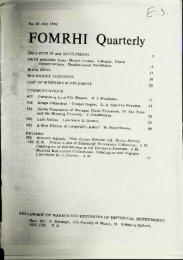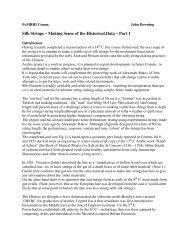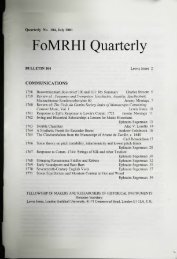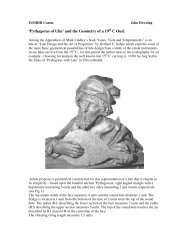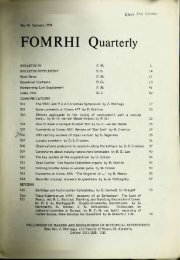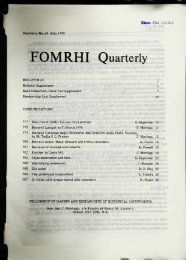•rf - FoMRHI
•rf - FoMRHI
•rf - FoMRHI
You also want an ePaper? Increase the reach of your titles
YUMPU automatically turns print PDFs into web optimized ePapers that Google loves.
Bull.5. page 2<br />
your colleagues. Also pass on the ideas that may work and may not;<br />
Paul Hailperiti's note on burnt bores herewith is a case in point. And<br />
if such a note gives you an idea, let's have it. Paul's has n;ade me<br />
wonder whether part oi' the trouble with lnthe-bored bores might be the<br />
speed of turning; has anyone tried a bow-lathe? Laurence Hcken has a<br />
good description of free-hand turning, with a bow-turned tool but not<br />
in a lathe, in his Folk iiusical instruments of Turkey (pp.413-417 and<br />
488-491), ore reason that 1 wrote such a rave review of this book in<br />
Early Music. Is it possible that an advantage of free-hand boring is<br />
that one can feel if the tool is changing course and can move the work<br />
slightly to compensate, so maintaing a straight bore? I don't know<br />
whether a tool can be ground to cut in both directions of rotation, but<br />
if so, then the change of direction on each bow stroke would avoid, or<br />
at least compensate for any tendency for the drill to move sideways in<br />
its direction of rotation.<br />
REPLIES TO QUERIES: If you can answer a question which you see in the<br />
Bulletin, it can sometimes be useful to send me a copy of your reply.<br />
Ture Bergstr^m asked last time about tools for turning the inside bores<br />
of great bass recorders and similar instruments. Paul Hailperin has<br />
suggested using bull-nosed single twist augers, which he has bought<br />
from Vm.Ridgway 4 Sons Ltd., Oscar Works, Sheffield 3» England. He<br />
also suggests for conical bores that one can make reamers by latheturning<br />
a piece of hardwood to the desired profile, then cutting away<br />
nearly half of the diameter, screwing on a steel biade and filing the<br />
biade to follow the contour of the wood. Stephen Taggart has thought<br />
of using an old bayonet as a reamer, one of the old Lebel French ones<br />
which can be bought quite easily in those 6hops whicn sell antique<br />
weapons; these, he says, are cruciform in 3ection (I seem to remeraber<br />
seeing triangular section ones also), 300 mm. long and tapering from<br />
14 mm down to 4*3 mm. Cost he thinks would be about C10-C12.<br />
FOLLCW-UP TO PREVIOUS EULLETIIiS: Stephen Taggart sent me a sample of<br />
his synthetic ivory (a ferrule for the blow-pipe socket on a Uorthumbrian<br />
bagpipe bellows); at a distance of one foot it looks like ivory.<br />
It doesn't feel the same to the touch and I think that it is lighter in<br />
weight, which could affect its use as a ferrule on a sound-producing<br />
tube, but certainly for appearance it eeems fine. I have had a long<br />
note from John Betts on the subject, which I have asked him to write<br />
up properly for us, but in case he hasn't done so in time, I pass on<br />
two warnings: a) as the resin polymerises it produces a lot of heat and<br />
can explode violently; b) be careful when machining it - always do it<br />
wet because the dust can produce severe irritation to the noce which<br />
can persist for several years. Stephen 'i'aggart c^ys that he has had no<br />
problems with either of these, but bear the warnings in mind. There<br />
is another note on synthetic ivory herewith, and we would welcome more,<br />
since the ever-rising cost of genuine ivory is a problem for irany of us.<br />
I said in Bull.4 that Tom Beeston has some useful jigs. He asks me to<br />
say that he has not had time to sit down and draw these and describe<br />
them, and he's not sure when he will have the time. he asks me to apo—<br />
logise to those who wrote to him and to whom he has not yet replied,<br />
end to say that he is keeping a file of names and addresses and hopes<br />
to get down to it some time, but no promises.<br />
John Betts says that he hasn't get very far with his 'anti-bug' agent<br />
experiments because nebody except me has sent him any odd bits of wood<br />
that he can try various agente on and then see if the bugs will eat<br />
them or not. Surely we ali have this problem of bugs and rots and so<br />
on getting at our instruments; haven't most of you got a box or sack of<br />
scraps of instrument wood that he could try on? If you bave, put a<br />
-3-





